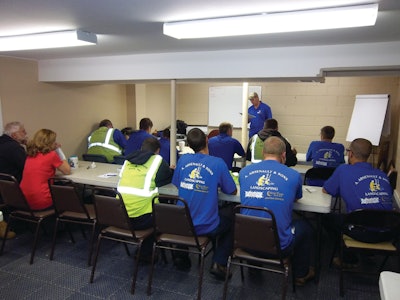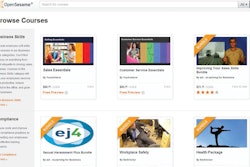
In today's lawn care and pest control industries, a company's biggest competitive advantage could very well be the performance and quality of its employees, according to Craig Goodwin, a 30 plus-year veteran of the pest control industry.
As the senior director of Rollins University, Goodwin manages instructional design and instructor teams at Rollins Inc., an Atlanta-based company that provides pest control services to more than 2 million customers around the world. One well-known Rollins subsidiary is Orkin.
Goodwin spoke to a crowd of lawn care business owners at the 2014 Lawn Care Summit in Nashville. He said there are basically four levels of training being provided by companies today:
- None, with licensees simply being expected to recertify each period
- Provide CEU (continuing education unit) training to help licensees maintain certification
- Provide both CEU and developmental training
- Provide both CEU and developmental training, along with training to support new business initiatives
Goodwin conducted an impromptu, informal poll of contractors in the room. Nobody raised their hand for number one, most raised for number two, a few raised for number three, and very few raised for number four. In other words, the opportunity to gain a competitive edge by implementing a thorough training program exists for the majority of contractors in operation today.
I know what most of you are going to say: Training is just so expensive and time-consuming. As Goodwin points out, though, training must be viewed as an investment as opposed to a cost. Sometimes training is born out of necessity, i.e. certification and compliance. But sometimes it can be born out of opportunity, i.e. building a well-rounded team that can shoot your company past the competition. The time to focus on that opportunity is now.
Identify skills, train to those skills
Think about what it takes for your employees to perform well—from the standpoints of compliance, safety, efficiency and customer service. What do they really need to do and, thus, know?
"There's a big difference between need to know and nice to know," Goodwin points out. "If the content of the training doesn't help an employee perform their job better right away, it probably isn't necessary because the employee will forget what you trained them on in a year or so if they don't need to use it. Always be thinking about the Training Value Channel: Skills and knowledge should relate directly to the tasks being performed." When you keep this in mind, you're more likely to see the results you'd hoped for.
Training delivery
Once you determine what the training should be, you can think about how you're going to deliver it. "The most common method is instructor-led," Goodwin says. "But there are other methods available. The training landscape is drastically being changed by technology."
Consider the following:
- Self-directed training, i.e. provide employees with some kind of study guide
- On-the-job training, perhaps pairing newer employees with a veteran mentor for a certain period of time
- Classroom training featuring guest speakers from outside and/or inside your company
- Virtual training/eLearning via webinars, videos, etc.
A fifth training method, which happens to be Goodwin's favorite, is the use of job aids. "This is great for procedural and/or infrequent tasks, and for tasks that must be 100% accurate," Goodwin explains. Examples might include step-by-step checklists for properly servicing a maintenance account, mobilizing a crew in the morning, finishing up an installation job, or following up on a sales lead. "Using job aids is one of the most cost-effective ways to deliver training," Goodwin says. "There's no instructor, the employee gets it right every time, and employees don't have to learn and memorize. Remember, he who does the talking does the learning."
Elements of good training sessions
Once you determine what you should be training on and how you're going to administer the training, there are some additional best practices to consider that can help ensure a successful training endeavor.
Here's a quick look at some common elements of effective training sessions:
- If you are opting for a classroom-type approach, make sure the setting is formal yet comfortable
- Make the training interactive, as opposed to just standing up there and preaching
- Use visual aids such as handouts, a projector, video, etc.
- Provide food, be it lunch, breakfast, or just drinks and snacks
- Make it fun
- Outline the goals of the training session so everyone knows why it's important and what to expect
- Understand your audience and how to best engage them
- Separate the technical training from the more business-oriented training
- Ask questions and provide feedback
On the flip side, here are some elements of not-so-effective training sessions:
- Fail to engage the audience, almost a go-through-the-motions exercise
- Bombard with way too much information
- Information is too general and not specific to jobs/tasks
- No preparation
- Don't outline goals
- Bad environment, like a hot/humid workshop, for instance
- Trainer makes trainees feel stupid, belittled
Ways to make training stick
No matter how well-planned and effectively delivered your training initiative is, it's not a guarantee that all employees are going to learn everything you want them to. Your ultimate goal of training is to help employees go back to perform their jobs better and/or differently. To that end, the company owner and/or managers must play a huge role in making sure the training sticks.
Goodwin says there are some useful tools you can use:
- Test employees on the material you'd shared
- Test them on the job
- Ask for feedback and offer opportunity to ask questions
- Provide monthly quality control checks to make sure training continues to positively influence performance
- Reinforce how the training is directly linked to overall company goals
- Conduct performance reviews to revisit and/or update goals and expectations
"Good managers will continually review action plans with employees," Goodwin adds. "You provide opportunities to perform, coach and reinforce, providing learning resources, and identify good role models. Better yet, you act as a role model. Finally, providing feedback and recognition is very important."





















